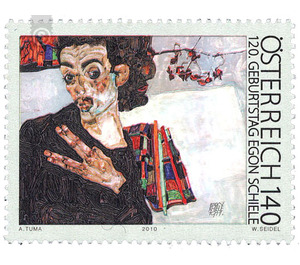120th birthday - Austria / II. Republic of Austria 2010 - 140 Euro Cent
Theme: Art & Culture
| Country | Austria / II. Republic of Austria |
| Issue Date | 2010 |
| Face Value | 140.00 |
| Edition Issued | 250,000 |
| Printing Type | combination printing |
| Stamp Type | Commemorative |
| Item Type | Stamp |
| Chronological Issue Number | 2210 |
| Chronological Chapter | OOS-OE2 |
| SID | 160169 |
| In 59 Wishlists | |
Egon Schiele (1890 - 1918) is undoubtedly one of the most important painters of the so-called Viennese Modernism. His expressionist work enjoys a worldwide reputation and thrills audiences as well as international art critics. On the occasion of the return of his 120th birthday, Österreichische Post now puts on a special stamp showing one of his most famous self-portraits from 1911. About the person: Schiele's extraordinary artistic talent was recognized early on. At the age of only 16 he was admitted to the Vienna Academy of Fine Arts, but after two years he was tired of orderly everyday life and left again to found the "Wiener Neukunstgruppe" together with some other young artists. After first successes, he soon fell to the art critic Arthur Roessler, who should play a crucial role in Schiele's career. Through his mediation, he met the art collectors Carl Reinighaus and Oskar Reichel know that financially secured his beginning in the Viennese art scene and provided him with several commissioned works. In 1910 Egon Schiele left Vienna and lived first in Krumau and then in Neulengbach, where he had to spend some time in custody for alleged sexual assault against minors or because of the distribution of indecent drawings. In 1912 he returned to Vienna, and with the help of his paternal friend Gustav Klimt, he was able to gain a foothold here again and soon afterwards celebrate great successes. Shortly after the beginning of the First World War Schiele was drafted into the military administrative service - and before his transfer to Prague, he married his longtime girlfriend Edith Harms. He later became k.u.k. for six months. Heer Museum, where he organized war exhibitions and was able to pursue his painting despite the war. With the death of Gustav Klimt in 1918, Schiele became a major star on the Viennese art scene. Numerous exhibitions and various events helped him to many assignments. Towards the end of the war, 1918, Vienna was hit by a catastrophic flu epidemic. Edith Schiele, who was six months pregnant, succumbed to this disease - and Egon Schiele also became infected and died at the age of 28 on October 31, 1918 in Vienna-Hietzing. Egon Schiele's oeuvre (self-portraits, nudes, landscapes and cityscapes) is world famous. His unmistakable style speaks of high artistic genius and enjoys unrestricted admiration - both in the generally popular as well as in the scientifically reputable area. Numerous renowned museums around the world host the works of this great Austrian artist.


